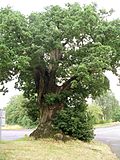Baginton
| Baginton | |
| Warwickshire | |
|---|---|
 Coventry Road, Baginton, with Coventry visible beyond | |
| Location | |
| Grid reference: | SP3474 |
| Location: | 52°22’12"N, 1°29’24"W |
| Data | |
| Population: | 801 (2001) |
| Post town: | Kenilworth |
| Postcode: | CV8 |
| Dialling code: | 024 |
| Local Government | |
| Council: | Warwick |
| Parliamentary constituency: |
Rugby and Kenilworth |
Baginton is a village in Warwickshire. It had a population of just 801 recorded in 2001.
The village is four miles south of Coventry city centre and seven miles north of Royal Leamington Spa. It is the site of Coventry Airport.
In the centre of the village is the Lucy Price Playing Field.
About the vilage
Coventry Airport (built in 1936 as Baginton Aerodrome) is by the village; it served as RAF Baginton during the Second World War. The Lunt Roman Fort and the ancient "Baginton oak" tree are within the village, whilst the Midland Air Museum and Electric Railway Museum, Warwickshire are just outside Baginton.

The road from Baginton to South Coventry passes over the River Sowe near an old mill.
Parish church
The Church of St John the Baptist is situated in the old part of Baginton. A scenic footpath starts near the church and leads to Stoneleigh.
History
The Domesday Book records that in the 11th century Baginton consisted of 15 households and a mill.
Coventry Airport
- Main article: Coventry Airport
Coventry Airport lies just southeast of the village. First opened in 1936 as Baginton Aerodrome, it has been used for general aviation, flight training, and commercial freight and passenger flights.
The Midland Air Museum on Rowley Road is adjacent to the northern boundary of Coventry Airport.
Landmarks
Lunt Fort
The remains of the ancient Roman Lunt Fort have been found in Baginton on the south side of the village. Parts of the fort were reconstructed in the 1970s, and it has become a popular site for school visits, as well as holding activity days during the summer.
Baginton Castle and Fish Ponds

Henry Percy, 1st Earl of Northumberland was imprisoned at Baginton castle following his son, Harry Hotspur's defeat at the Battle of Shrewsbury.[1] There stands in the town the ruin of a house of that age, a late fourteenth-century house, but it is not well known due to its location in an area of woodland on private land.
Of Baginton Castle no trace remains if it stood as a castle, and it may have been on the same spot. The area was fenced off in 2006, and now the ruins and former Fish Ponds can be viewed by arrangement with the local farmer who owns the land.
Baginton Castle and Fish Ponds are Ancient Scheduled Monuments (Numbers: 21540-1 and 21540-2).
Baginton oak tree

Baginton is the site of an old oak tree which is often called the Baginton oak. It is about 300 – 350 years old and is thought to be one of the oldest trees in Warwickshire. A nearby public house is called The Oak.
There is also an old proverb about a boy called Elliott who sits under the tree when he has to contemplate decisions.
Gallery
-
The Baginton oak in summer.
-
The Baginton oak in summer.
-
The Lucy Price playing field.
-
Coventry Airport gates, Baginton.
-
St John the Baptist Church, Baginton.
-
Reconstructed main gate (inner aspect) of Lunt Fort
Outside links
| ("Wikimedia Commons" has material about Baginton) |
References
- ↑ J. M. W. Bean, 'Percy, Henry, first earl of Northumberland (1341–1408)', Oxford Dictionary of National Biography, Oxford University Press, 2004; online edn, May 2005
- Domesday Book
- Dugdale, Sir W. 1730 The Antiquities of Warwickshire, 2nd Ed. (ed. W. Thomas), London
- Edwards, J.H. 1953 'Baginton Castle Excavations', Trans. Birm. Warwicks. Arch. Soc., 69 (1951), 44-49.
- Smith, W. 1829 A New and Complete History of the County of Warwick, Birmingham





